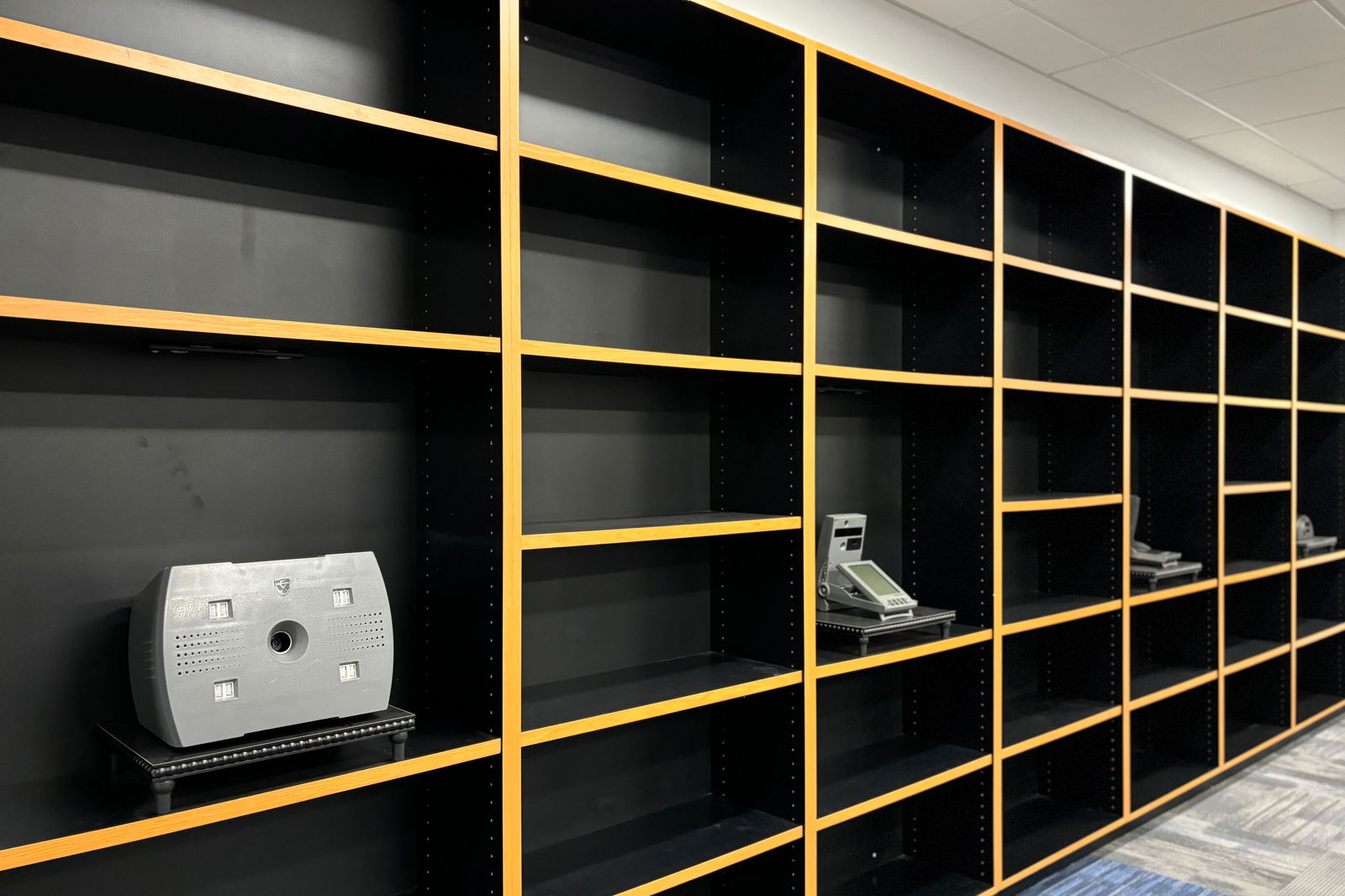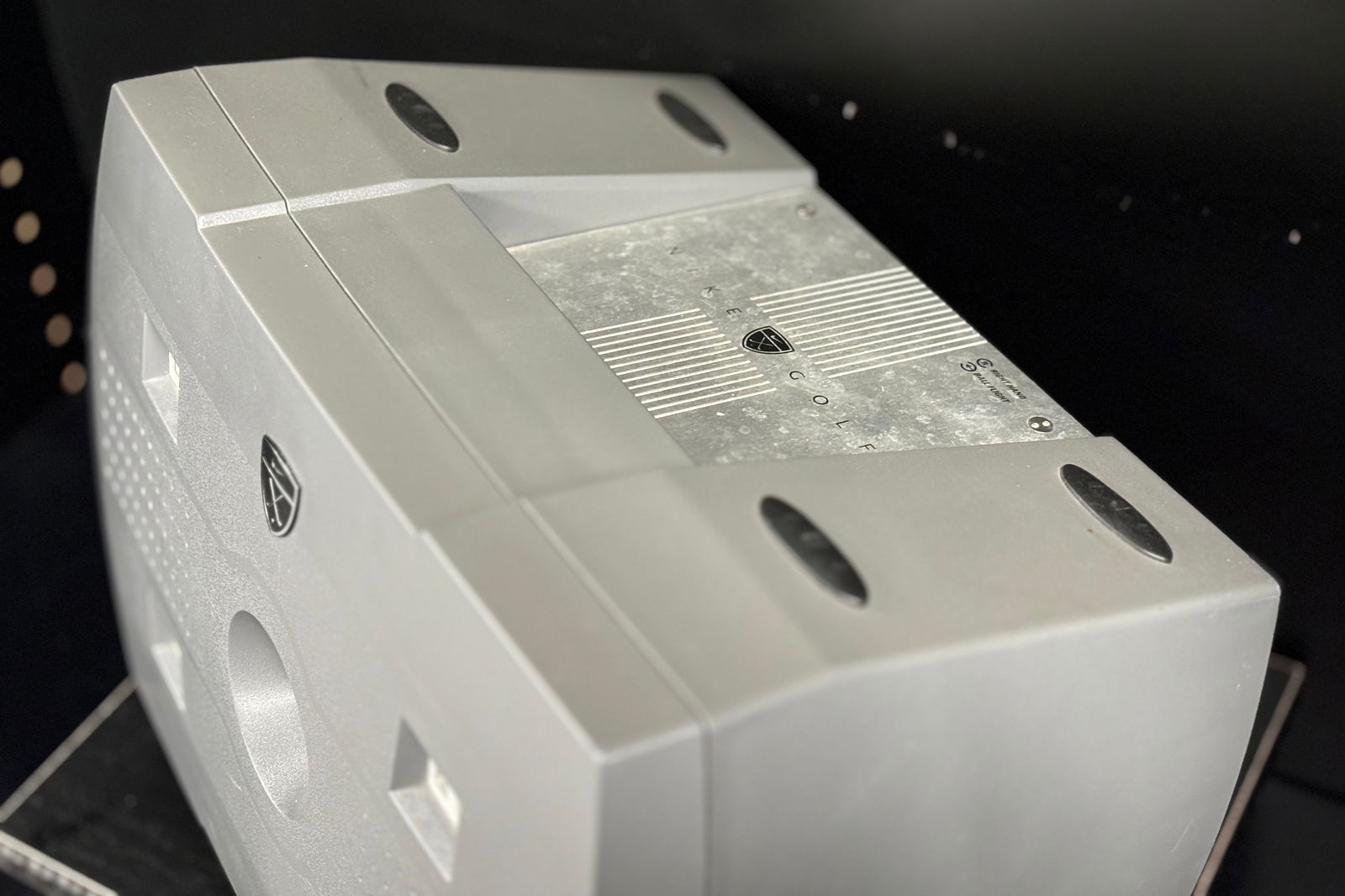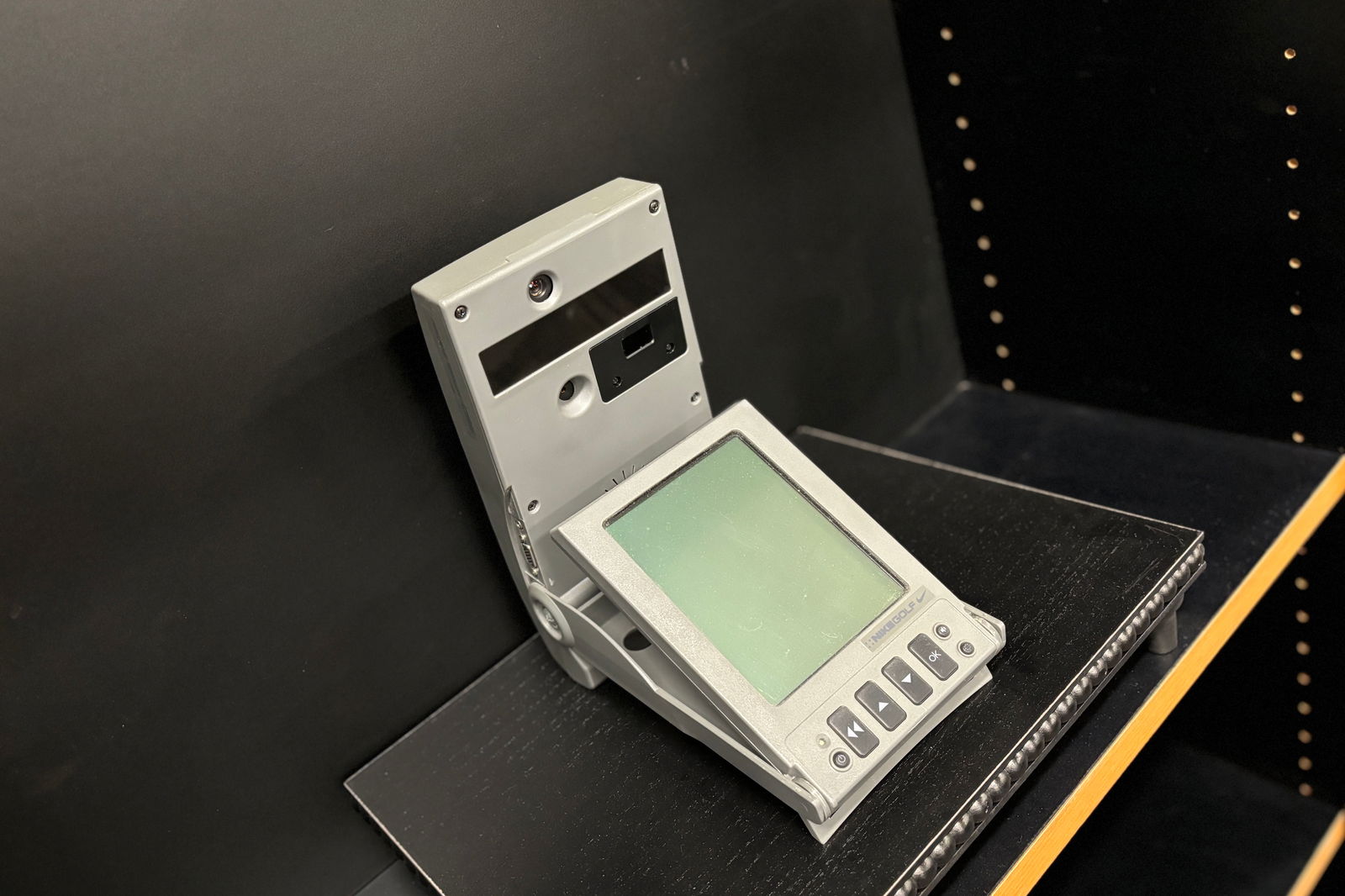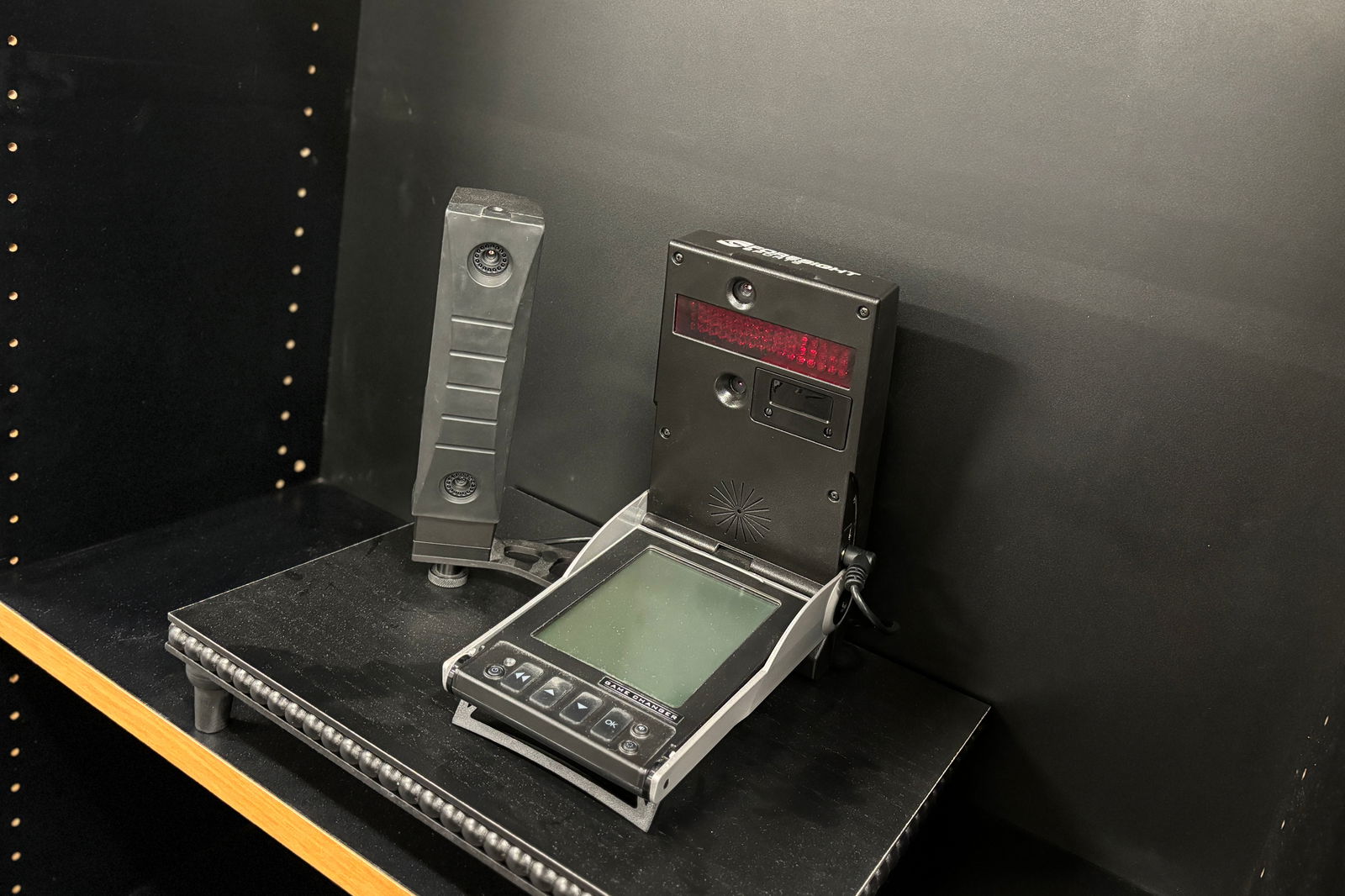It’s a typical coastal morning as I walk off the street in San Diego and onto the driving range. A thin veil of June gloom hangs in the air, but there’s no marine layer, no light wind, no variables on the green that could hurt my game—unless I want them. I’m at the headquarters of Foresight Sports, teeing up in a top-of-the-line golf simulator programmed as beginner-friendly as possible, and conditions are optimal for me to … whiff.
I tee off again and duff it. I tee off again and manage to shank it, but at least I hit the screen, which might be a depressing improvement. You can put a perfectly weighted blade in my hand, but that doesn’t mean I know how to wield it. There’s only one other person in the room, but I feel like multiple sets of eyes are judging me. Then metrics pop up on the screen because the only thing really paying attention to me is the GCHawk, a bar of sensitive sensors mounted overhead. The GC stands for “Game Changer,” and with me, it’s got its work cut out to live up to that name. I don’t know what anything that it’s telling me means yet, other than it all means I can use all the help I can get. But I’m here to learn about five-figure launch monitors and whether their promise of data-driven insights can help turn game goals into reality—even if the reality is just turning me from, ugh, not good to, eh, not bad.
A backspin through history …
It’s an atypical coastal morning, at least for me, because I’m obviously not a golfer. Not an aspiring Rickie Fowler or Rory McIlroy. Not even a pre-Chubbs Happy Gilmore. Yet here I am, hacking it up in the heart of professional golf territory. Even if you’ve never set foot on a course in Southern California, there’s a good chance a SoCal product has been on the green with you. After taco stands, golf equipment manufacturers might be the second most populous business here. Some of the biggest names in clubs and components and luxury carry have development facilities and fitting studios between North County and the North City edge, where you’ll find Foresight tucked away between business parks and condo communities.
However, Foresight’s love of San Diego is not centered around available real estate. The perfect year-round climate, courses, and clientele are just a few of the reasons that invaluable real-world testing is a 365 possibility. But you don’t need to go to San Diego, or even your local pro store, to see the company’s launch monitors in use. If you’ve watched the PGA Tour, Korn Ferry Tour, or LIV Golf recently, chances are you’ve noticed a calf-height, hourglass-esque device sitting very demure, very mindful on the fairway alongside some of the biggest names in golf as they warm up.
That’s the QuadMAX, a best-in-class launch monitor that debuted in January 2024 and is the portable version of the advanced indoor array where I started my day. And it’s designed and assembled just a few stairwells away from where I’ve established my baseline embarrassment. I’m met at the lab by Foresight Marketing Manager Christopher Dunlap and Chief Technology Officer Paulo Merlotti, who will walk me through the company’s history and what goes into getting the best out of a launch monitor launch.
The QuadMAX is an update to 2016’s GCQuad, which introduced the high-speed four-camera system that sets this photometric monitor’s accuracy and versatility apart from radar- and infrared-based systems. Capturing thousands of frames per second (depending on lighting conditions) and tightly tracking club and ball from multiple angles, the photometric system can provide nearly instantaneous, millimeter-accurate feedback on ball speed, clubface angle, impact location, launch angle, and more.
Pro-grade golf balls can promise you low spin rates, but it takes skills and a reliable launch monitor to know if the spheres really deliver. Radar, meanwhile, focuses more on full ball flight after impact, so space is required to track trajectory. This makes radar excellent for longer-distance analysis, but photometrics are perfectly at home on the driving range while excelling at indoor use and short-game (chipping and putting) applications.
The GCQuad reinforced Foresight’s reputation for producing a portable performance tracker/personal coach that can give detailed insights on every shot—whether you’re in a high-volume or low-velocity mood. The QuadMAX adds additional data points, a bright touchscreen instead of physical buttons, simplified NFC connectivity, the “MyTiles” customizable metrics display, an increased battery, decreased weight, as well as ergonomic, stability, and durability improvements. That’s a huge evolution from 2006’s G1, which used a monoscopic camera and a motion-tracking system originally developed to track bullets.
Don’t mean a thing if it ain’t got that swing …
The golf ball-tracking G1 “lunchbox” was developed for Nike by an engineering team that would eventually become part of Foresight Sports. And over the years the team, led by Jon Watters and Scott Werbelow, grew as product size shrank—flourishing because they saw the need to prioritize portability and versatility equally.
Watters and Werbelow worked in golf simulators but saw the consumer potential of technology that would blur the lines between that experience and performance analysis tools and could be used both indoors and outdoors because, at the time, there was a broad gap between simulators for home entertainment and $50,000 tracking boxes you’d only see on professional grass. So, they took a gamble and formed a company to acquire the technology behind the G1 and find a way to take it to market.
The vision was to one day have a launch monitor be as standard for a caddie to carry as a laser rangefinder already was. There was, of course, no guarantee things would succeed. That reality was baked right into the company’s name: WAWGD, Inc. DBA Foresight Sports. The WAWGD being “What Are We Going to Do.” The What being either make launch monitors a thing or give it all up to start a taco truck.
Well, there are a lot of tacos in San Diego, but none under the Foresight umbrella, because the company never zigged when it should have zagged, never took a merely OK deal or opportunity. Though there was internal debate about whether the GC2 (named, you might have guessed, for its stereoscopic camera system) was fully polished, the founders took a calculated risk and launched at the 2010 PGA Show. Next thing you know, they had to draft staff to help with a surge of demo demands.
“In a world where everyone else was like, well, you’ve got to calibrate it and it’s going to be 10 minutes to set up, we were the first product to be able to come out where you just set it down on a tee box and press a button and, man, off you go … getting data,” says Werbelow over lunch (fish tacos, naturally).
“And we defend ourselves, our product’s reputation, through the data, through being the most accurate. Even an indiscernible shift can significantly impact distance, so you have to be able to measure with precision, not make a 2mm error. That’s why pros pay for it—accuracy and ease of use—and if you know tour guys you know they usually don’t pay for anything. But we don’t give them product and the world can still see them using it week in and week out.”
Merlotti worked on sports imaging at Wintriss Engineering, the firm working on the G1 successor, the G100, and partnered with Foresight to develop the GC2. Between 2010 and 2012, the team added GC2 clubhead tracking—also known as HMT (Head Measurement Technology)—and Foresight added Merlotti to the C-suite. Merlotti admits to being a long-time photography enthusiast, especially medium- and large-format cameras. This love of capturing the granular details that form a larger landscape plays well with decades of developing optical “tricks” and algorithms for camera systems and real-world object tracking.
For years, Foresight kept growing without crowing, working on the next iteration without beating chests and screaming at the industry or media. And in 2016 Foresight introduced that product: the GCQuad, featuring quadrascopic imaging. It quickly became a benchmark, and the company went from being hunters to being the hunted. The pandemic raised the demand for indoor activities, and Foresight answered in 2021 with a model, the three-camera G3, that lowered the cost of entry from $19,999 to only $6,999. Now comes the QuadMAX. Now comes the tour.
A little birdie told me …
Way before they join stretchy slacks and colorful polos as essential accessories, Foresight products start, like most, with whiteboards and black boxes. Merlotti walks me past model diagrams and rapid-prototyping 3D printers, cubicles and exposed circuit boards, oscilloscopes and test benches. New product testing, current product support, and specialized equipment development that supports all of it begins here. Beyond all the computer-aided design—all the mechanical, electrical, and firmware engineering—there’s the reconfigurable optics lab for testing lenses and lights. And then there’s the production line. Make that multiple production lines.
The current Foresight production facility, which has been occupied since 2020, isn’t sprawling but still manages to house over 200 employees and multiple shops simultaneously. There’s the specialized tooling and semi-automated assembly for the higher-volume GC3—multiple matrixes of molded housings and carefully machined blocks, each one etched with an Easter egg: “Hello from San Diego, CA” and the longitude and latitude of Foresight HQ. Lining the walls are racks and racks of simultaneous calibration rigs, some for redundancy and some overload capacity. “If a component is going to fail, we want it to fail here, in-house,” says Merlotti. “We do burn rate … battery discharge … physical stress tests and simulated ball strikes. We internally exercise the systems to ensure they meet performance standards.”
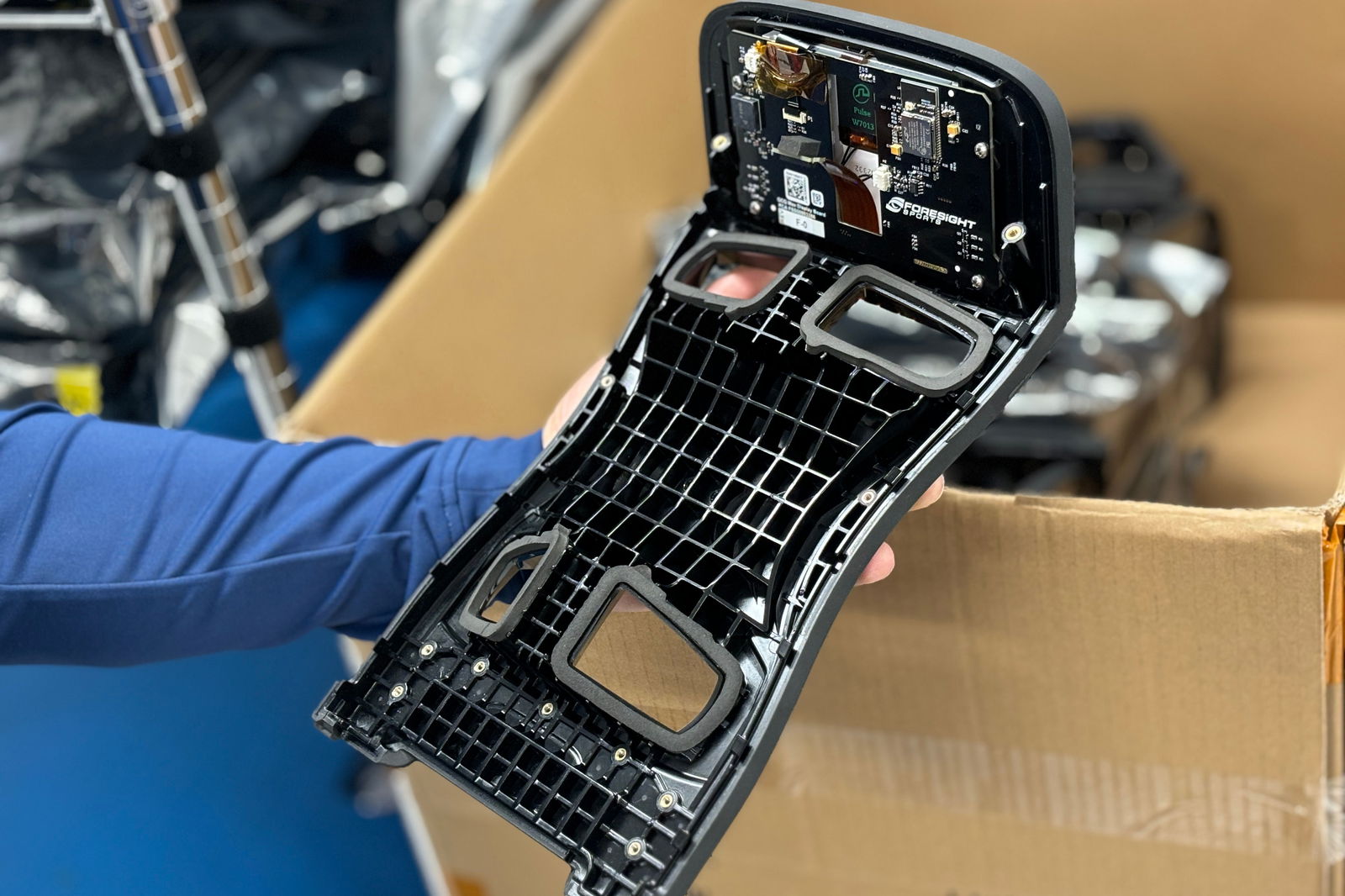
And then there’s the more traditional line for lower-volume, higher-complexity products, including the GCQuad, GCHawk, and QuadMAX—a series of construction and computer vision stations. Seen unassembled, the front plate of the QuadMAX recalls a Viking visage—a spectacle-style facial shield of display circuitry and fiberglass honeycombs with foam gaskets adding definition to the cutouts. Like a warrior would defend their eyes, the QuadMAX safeguards its optics because the utmost care is taken to focus those four lenses before they are bonded in place and exposed to a proprietary light constellation for 3-D alignment.
From the outside, the QuadMAX may look like a smooth slab of plastic, but this inner latticework is tested to withstand the impact of a 70-mph golf ball. Foresight’s research found a typical shank travels at 60 mph, so a safety margin of structural integrity was added in. A refreshed magnesium suspension chassis is less dense but has the same tensile strength as aluminum, shaving off weight without sacrificing stability. As for the foam, it’s there to absorb energy and expansion, to minimize internal movement so the deliberately oriented components never touch external surfaces that could spoil calibration. Compared to rubber, there’s no bounceback.
“These cameras cannot move over time or over temperature … so the QuadMAX is made in a way that endures over the years, over impact, over humidity,” says Merlotti. No matter how many times a QuadMAX might get picked up, carried, dropped, it should withstand rough handling. I’m even shown a GCQuad that survived a rough ride or two alongside World Long Drive Champ Martin Borgmeier but kept functioning, side-to-side cracks rippling across the LCD, fragmented but still operative.
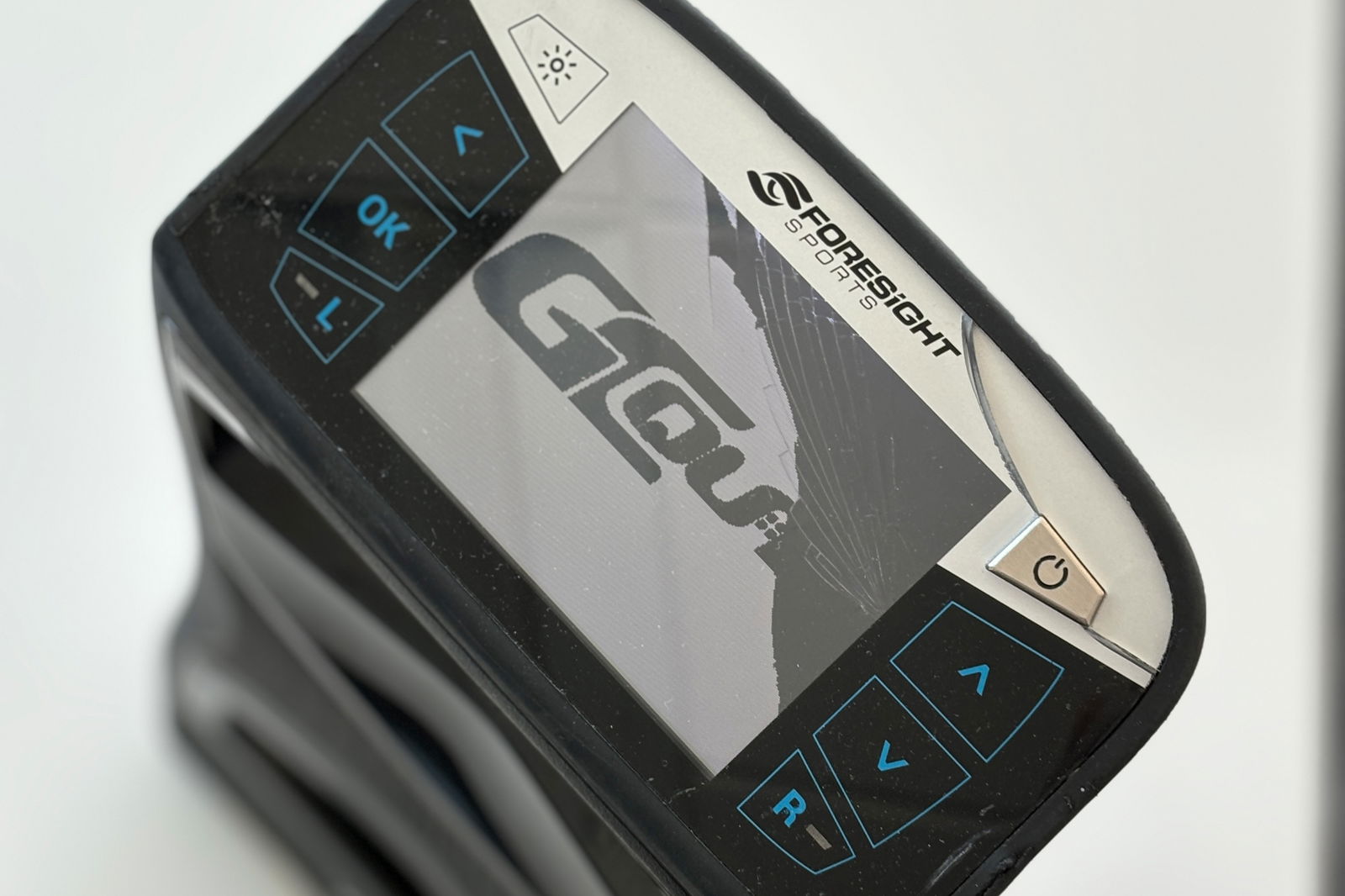
The grass is always greener …
It’s time to put another golf club in my hands for proof of concept. But instead of ripping slappies at the office, we’re taking one of these highly transportable units just a few miles away to Torrey Pines Municipal Golf Course, which sits at the lip of the Pacific Ocean. It’s a course I’ve seen from a distance without realizing it, a swatch of the coastline I spied on the horizon while hiking through Torrey Pines State Nature Preserve a day earlier. That’s how engrained golf really is in the business and physical landscape of San Diego.
Drive for show, putt for dough, they say. I’m not threatening anyone’s livelihood, but I’m open to data-driven insights. Whether for equipment fitting or on-course performance, the QuadMAX quickly shows what it can quickly show when it comes to how I’m presenting the club. I don’t really know my pendulum from my pivot, but I’m aiming for forward roll with minimal backspin, managing my misses rather than aiming for perfection. And real-time feedback on everything from face angle to impact location to path direction to the distance of skid before true roll begins quickly has me self-correcting serious inconsistencies in how I paint my stroke.
Quick glances at the customized instruction-friendly QuadMAX display help me start to get a proper gauge of the desired backswing and magic speed number for specific distances and greens, how to achieve center-face contact on my intended line more consistently. Am I suddenly Bryson DeChambeau, suddenly Master material? No, I’m no scientist, but I’m changing my grip with intent, recalibrating where I take the club behind deliberately. I’m only out for an hour, but my forward press engrosses me to the point that I don’t even notice the military aircraft loudly flying overhead till we’re packing the car back up. And if I hadn’t wanted to use that instant feedback, a QuadMAX can save the apex, descent angle, etc. etc., of up to 2 billion shots, so I could try to hit a fighter jet now and analyze it in the Foresight app later.
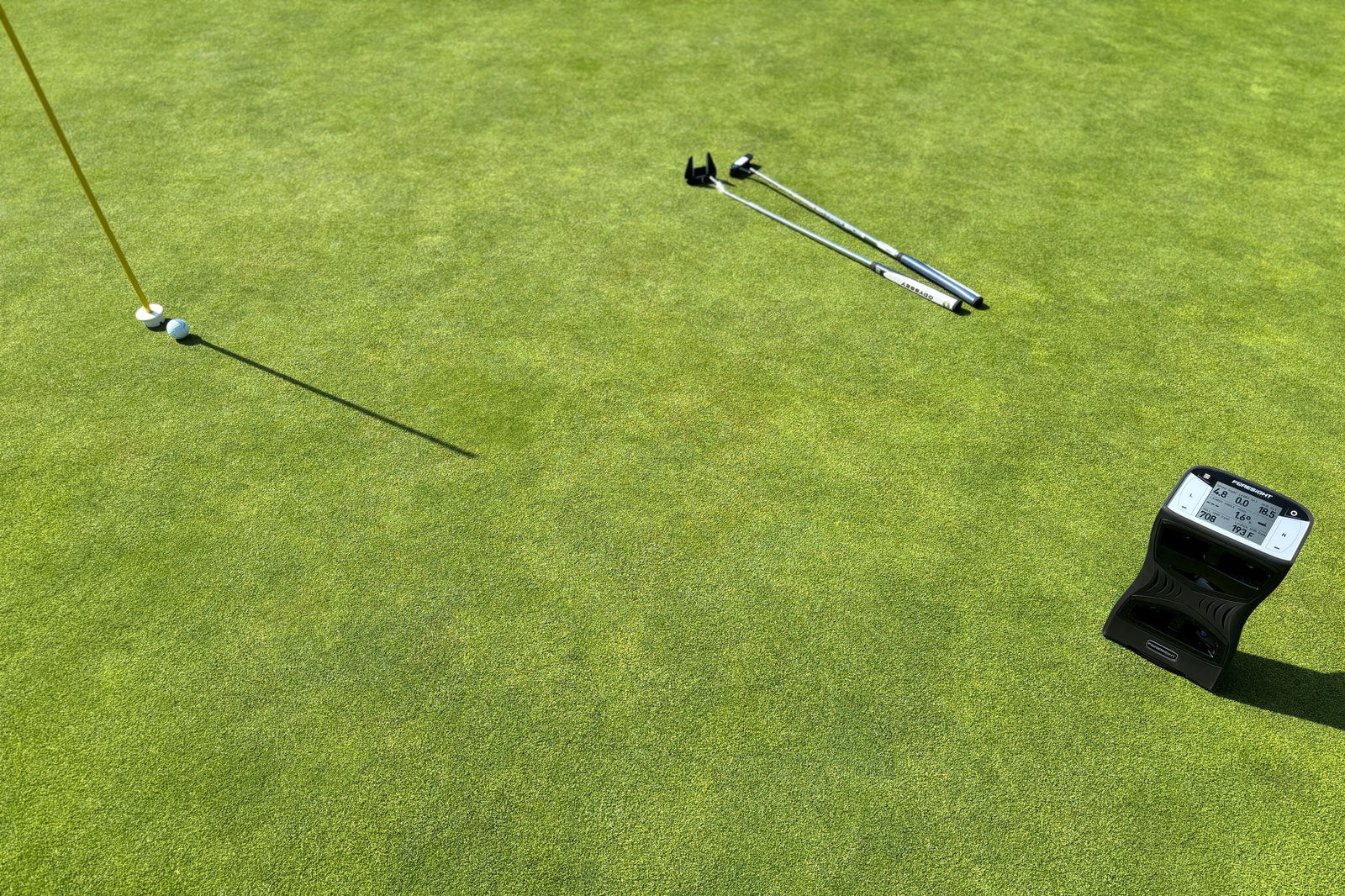
And that’s the tee …
It’s a typical coastal afternoon as I walk off the street in San Diego and onto Hole 7 at Pebble Beach. The bluff is windy, the bunkers intimidating. OK, I’m still at Foresight headquarters back in the hitting bay, where conditions are always optimal for using what I’ve learned in a day. I definitely started out a bit of a grounder with one hell of a slice but have dialed my exaggerated motions back to the point I can semi-consistently hit a path close to zero and avoid some wormburners. Reviewing my shot sessions, whether visually or as a measurements-enriched CSV, my groupings get progressively further downrange and more centered. My arm position, weight transfer, ability to reduce tension while controlling unwanted clubface manipulation … my connection to the club and the confidence to control my pace were all infused in the metrics.
Of course, some places have actual seasons. Or the golf course isn’t as convenient. Or the only time to slip in a short sesh on a lunch break. That’s when a QuadMAX (or GCQuad) and Foresight’s virtualization comes into play—whether it’s “real-world” settings for a collegiate golfer or a conduit for an e-gamer. Just stick a reflective fiducial (aka sticker) to a swing stick, even a broomstick, and you can use the speed-tracking mode. Swap in a real club, a ball, plus a net/screen, and not only can you fine-tune your swing, but you can play true-to-life rounds or take a PinSeeker cash challenge from the comfort of a room as easily as at a range.
I’ve been introduced to a lot of new things in San Diego, not the least of which are new muscles in my back. A few days earlier, I was running mosh pit border control at an all-day hardcore festival, and now, after just a couple hours doing practice shots, I’m chewing twice the Tylenol. So, I take a few days to recover before I head to Top Golf with my kid, who actually golfs semi-regularly and has laughed at my prodigious shanks before. (Yes, it felt good making him hella jealous that I got to use a QuadMAX and get professional pointers.)
It’s a typical congested morning as we walk off the street near National Harbor, Maryland, and onto the driving range. I have no doubt a QuadMAX can help a professional actualize their last one percent, but we’re here to see if this aspiring amateur managed to carry its wisdom on getting better carry. I take the best advice the Foresight Sports crew gave me that wasn’t numbers-based and do a few stretches. Then I step up, tee off, and hear a surprised voice behind me testify to the advantage of a premium launch monitor: “Heeeey, not bad.”



